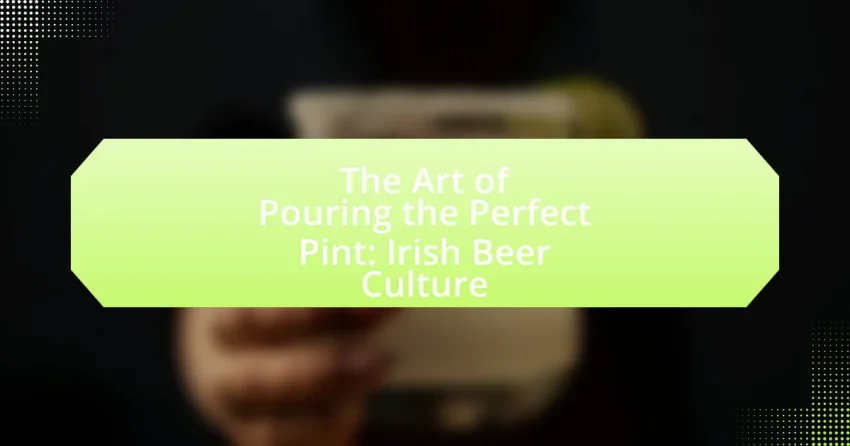The main entity of the article is Irish beer culture, which encompasses its historical significance, communal aspects, and global influence. The article explores the evolution of this culture from its origins in the 12th century to its current status, highlighting key historical events and regional differences that shape various beer styles. It emphasizes the importance of the pint glass in enhancing the drinking experience and discusses the role of community in Irish pubs, including customs and etiquette associated with drinking. Additionally, the article provides insights into pouring techniques, ideal serving temperatures, and food pairings that enhance the enjoyment of Irish beer, ultimately celebrating the rich traditions and practices that define this cultural phenomenon.

What is the significance of Irish beer culture?
Irish beer culture is significant due to its deep-rooted traditions, social importance, and global influence. The culture is characterized by communal drinking experiences, particularly in pubs, which serve as social hubs for communities. Historically, Ireland has produced renowned beer styles, such as stouts and ales, with Guinness being a prominent example, contributing to the country’s identity and economy. The brewing industry in Ireland supports thousands of jobs and attracts millions of tourists annually, highlighting its economic impact. Additionally, Irish beer culture has influenced brewing practices worldwide, promoting the craft beer movement and inspiring brewers globally.
How has Irish beer culture evolved over time?
Irish beer culture has evolved significantly from its early origins in the 12th century, when brewing was primarily a domestic activity, to a vibrant industry characterized by global recognition and innovation. Initially, beer was brewed in monasteries and homes, with local ingredients and traditional methods. By the 18th century, the establishment of commercial breweries, such as Arthur Guinness’s brewery in 1759, marked a shift towards mass production and the development of iconic styles like stout. The 20th century saw the rise of craft breweries, which emphasized quality and local sourcing, further diversifying the beer landscape. Today, Irish beer culture is celebrated worldwide, with events like the Dublin Beer Festival showcasing both traditional and contemporary brews, reflecting a blend of heritage and modernity.
What historical events have shaped Irish beer traditions?
The historical events that have shaped Irish beer traditions include the introduction of brewing by the Celts around 500 BC, the establishment of monasteries in the early Middle Ages which became centers for brewing, and the impact of British colonial rule in the 17th and 18th centuries that led to the rise of large-scale commercial breweries. The Celts utilized local ingredients to create early forms of beer, while monasteries refined brewing techniques and contributed to the development of styles such as stout and porter. The colonial period saw the emergence of iconic brands like Guinness, which was founded in 1759, and the subsequent industrialization of brewing in Ireland. These events collectively influenced the evolution of Irish beer culture, establishing a rich tradition that emphasizes quality and community.
How do regional differences influence beer styles in Ireland?
Regional differences significantly influence beer styles in Ireland by shaping the ingredients, brewing techniques, and flavor profiles unique to each area. For instance, the use of local water sources, such as the mineral-rich waters in Dublin, contributes to the distinct taste of stouts like Guinness, while the softer waters in the west favor lighter ales. Additionally, historical factors, such as the influence of British brewing traditions in Northern Ireland, lead to variations in styles like porters and pale ales. The craft beer movement has also diversified regional offerings, with breweries in places like Galway experimenting with innovative flavors and styles, reflecting local culture and preferences.
Why is the pint glass important in Irish beer culture?
The pint glass is important in Irish beer culture because it symbolizes the communal experience of enjoying beer, particularly iconic Irish stouts like Guinness. The design of the pint glass, with its wide mouth and sturdy base, enhances the drinking experience by allowing for a proper head of foam, which is essential for flavor and aroma. Additionally, the pint glass is often associated with traditional Irish pubs, where socializing and sharing a drink are central to the culture. This connection is reinforced by the fact that Guinness, a leading Irish beer brand, has historically promoted the pint glass as the preferred vessel for serving its product, emphasizing the importance of presentation and enjoyment in Irish beer culture.
What are the traditional types of pint glasses used in Ireland?
The traditional types of pint glasses used in Ireland include the straight-sided pint glass, the tulip-shaped glass, and the Irish pub glass. The straight-sided pint glass is commonly used for serving lagers and ales, while the tulip-shaped glass enhances the aroma of stouts and porters. The Irish pub glass, often featuring a thicker base, is designed for durability and is typically used in pubs across Ireland. These glasses are integral to the Irish beer culture, as they are specifically designed to enhance the drinking experience of various beer styles.
How does the choice of glass affect the beer experience?
The choice of glass significantly affects the beer experience by influencing aroma, flavor perception, and carbonation retention. Different glass shapes are designed to enhance specific characteristics of various beer styles; for example, a tulip glass concentrates aromas, enhancing the sensory experience, while a pint glass may dilute these qualities. Research indicates that the right glass can improve the overall enjoyment of beer by allowing drinkers to appreciate its full range of flavors and aromas, as supported by studies showing that beer served in appropriate glassware is perceived as more flavorful and aromatic compared to those served in generic containers.
What role does community play in Irish beer culture?
Community plays a central role in Irish beer culture by fostering social connections and shared experiences among individuals. Pubs serve as communal hubs where people gather to enjoy beer, engage in conversation, and participate in traditional music and storytelling, reinforcing a sense of belonging. This communal aspect is evident in events like St. Patrick’s Day, where collective celebrations highlight the importance of community in enjoying Irish beer. Additionally, local breweries often emphasize community involvement by sourcing ingredients from nearby farms and hosting events that bring residents together, further solidifying the bond between beer and community in Ireland.
How do pubs serve as social hubs in Irish society?
Pubs serve as social hubs in Irish society by providing a communal space where individuals gather to socialize, celebrate, and engage in cultural traditions. These establishments foster a sense of community through regular events such as live music, sports screenings, and traditional storytelling, which are integral to Irish culture. According to a 2019 report by the Drinks Industry Group of Ireland, pubs are central to social life, with 70% of adults visiting a pub at least once a month, highlighting their role in facilitating social interactions and connections among people.
What are the customs and etiquette associated with drinking in Irish pubs?
Drinking in Irish pubs involves several customs and etiquette that enhance the social experience. Patrons typically greet the bartender with a friendly “hello” or “how’s it going?” before ordering, reflecting the importance of social interaction. It is customary to buy rounds of drinks for friends, fostering a sense of camaraderie; this practice is deeply rooted in Irish culture. When receiving a drink, it is polite to thank the bartender, acknowledging their service. Additionally, it is considered respectful to wait for the host to raise their glass before toasting, as this signifies unity among those present. These customs are integral to the communal atmosphere of Irish pubs, where conversation and connection are prioritized.

How do you pour the perfect pint?
To pour the perfect pint, hold the glass at a 45-degree angle and begin pouring the beer down the side until it is half full, then straighten the glass and pour into the center to create a proper head. This technique ensures that the carbonation is preserved while allowing for a creamy, stable foam on top, which is essential in Irish beer culture. Studies show that a well-poured pint enhances the aroma and flavor, contributing to a better overall drinking experience.
What are the steps to pouring a perfect pint of Irish beer?
To pour a perfect pint of Irish beer, follow these steps: First, use a clean, dry glass, ideally a pint glass. Hold the glass at a 45-degree angle and begin pouring the beer slowly down the side until it is about halfway full. Next, straighten the glass and pour the beer directly into the center to create a head of about one inch. Allow the beer to settle for a few moments before serving. This method is essential as it enhances the beer’s flavor and aroma while ensuring the right amount of carbonation. The tradition of pouring beer this way is rooted in Irish culture, emphasizing the importance of presentation and taste in enjoying a pint.
What techniques ensure the right amount of head on the beer?
To ensure the right amount of head on beer, the pouring technique is crucial. Pouring at a 45-degree angle initially allows the beer to flow gently, minimizing excessive agitation and promoting a controlled formation of bubbles. As the glass fills to about three-quarters full, the pourer should straighten the glass and pour directly into the center, creating a controlled surge that generates a desirable foam head. This method is supported by the fact that a proper head enhances aroma and flavor release, contributing to the overall drinking experience.
How does the angle of the glass affect the pour?
The angle of the glass significantly affects the pour by influencing the flow rate and the formation of foam. When the glass is tilted at approximately 45 degrees, it allows the beer to flow smoothly down the side, minimizing agitation and reducing excessive foam. This technique is essential in Irish beer culture, particularly for stouts like Guinness, where a controlled pour enhances the drink’s texture and flavor. Research indicates that pouring at this angle can create a better balance between liquid and foam, resulting in a more aesthetically pleasing and enjoyable pint.
Why is the temperature of the beer important for pouring?
The temperature of the beer is crucial for pouring because it directly affects the beer’s flavor, aroma, and carbonation. When beer is served at the optimal temperature, typically between 38°F to 55°F depending on the style, it enhances the sensory experience by allowing the full range of flavors and aromas to be expressed. For example, serving a stout too cold can mute its rich, roasted flavors, while a lager served too warm may lead to excessive sweetness. Proper temperature also helps maintain the ideal carbonation level, preventing excessive foaming or flatness, which can detract from the overall enjoyment of the beer.
What is the ideal serving temperature for different types of Irish beer?
The ideal serving temperature for different types of Irish beer varies: stouts, such as Guinness, are best served at 6-8°C (43-46°F), while Irish red ales are optimal at 8-10°C (46-50°F). Lagers, including Irish lagers, should be served colder, around 4-6°C (39-43°F). This temperature range enhances the flavors and aromas specific to each beer style, ensuring an enjoyable drinking experience. Research indicates that serving beer at the correct temperature can significantly impact taste perception and overall enjoyment, as cooler temperatures can suppress flavors, while warmer temperatures can enhance them.
How does temperature impact the flavor and aroma of the beer?
Temperature significantly impacts the flavor and aroma of beer by influencing the volatility of aromatic compounds and the perception of taste. At lower temperatures, certain flavors, particularly those that are more delicate and nuanced, may be muted, leading to a less complex tasting experience. Conversely, as the temperature increases, the release of volatile compounds enhances the aroma, allowing for a fuller expression of the beer’s intended flavors. Research indicates that optimal serving temperatures vary by beer style; for example, ales are typically best served slightly warmer than lagers, which can enhance the perception of sweetness and bitterness. This relationship between temperature and flavor is supported by sensory analysis studies that demonstrate how temperature variations can alter the overall tasting profile of different beer styles.

What are the common types of Irish beer?
The common types of Irish beer include Irish stout, Irish red ale, and lager. Irish stout, exemplified by Guinness, is characterized by its dark color and rich, roasted flavors. Irish red ale, known for its amber hue and malty sweetness, is another popular style, with brands like Smithwick’s leading the market. Additionally, lagers, such as Harp Lager, are widely consumed in Ireland, offering a lighter and crisper alternative. These styles reflect the diverse brewing traditions and preferences within Irish beer culture.
What distinguishes different styles of Irish beer?
Different styles of Irish beer are distinguished primarily by their ingredients, brewing techniques, and flavor profiles. For instance, traditional Irish stouts, like Guinness, are characterized by their dark color and roasted malt flavors, while Irish red ales feature a lighter body and a balance of malt sweetness and hop bitterness. Additionally, the use of specific yeast strains and water sources contributes to the unique characteristics of each style. Historical context also plays a role; for example, the development of these styles is influenced by regional brewing traditions and the availability of local ingredients, which further differentiates them within the broader category of Irish beer.
How do stouts, ales, and lagers differ in flavor and brewing process?
Stouts, ales, and lagers differ significantly in flavor and brewing process. Stouts are characterized by their dark color and rich, roasted flavors, often featuring notes of coffee and chocolate due to the use of roasted malt. Ales, brewed with top-fermenting yeast at warmer temperatures, typically present a wide range of flavors, from fruity to hoppy, depending on the specific style and ingredients used. Lagers, on the other hand, are brewed with bottom-fermenting yeast at cooler temperatures, resulting in a clean, crisp taste with a smooth finish, often highlighting malt sweetness and subtle hop bitterness. The brewing process for stouts and ales involves fermentation at higher temperatures, while lagers require a longer fermentation and conditioning period at lower temperatures, which contributes to their distinct flavor profiles.
What are some popular brands of Irish beer and their characteristics?
Some popular brands of Irish beer include Guinness, Smithwick’s, and Harp Lager, each with distinct characteristics. Guinness is renowned for its dark, rich stout with a creamy head, featuring roasted malt flavors and a slightly bitter finish. Smithwick’s is an amber ale known for its balanced malt sweetness and subtle hop bitterness, offering a smooth and easy-drinking experience. Harp Lager is a crisp, light lager with a refreshing taste, characterized by its mild bitterness and clean finish. These brands exemplify the diversity and quality of Irish beer, contributing to the country’s rich brewing heritage.
How do food pairings enhance the Irish beer experience?
Food pairings enhance the Irish beer experience by complementing and elevating the flavors of both the beer and the food. For instance, traditional Irish dishes like stew or seafood chowder often pair well with stouts or pale ales, as the rich, malty flavors of the beer can enhance the savory notes of the food. Studies show that specific flavor combinations can create a more enjoyable tasting experience; for example, the bitterness of an Irish stout can balance the richness of a creamy dish, while a hoppy ale can cut through the fat in fried foods. This synergy not only improves the overall taste but also fosters a deeper appreciation for the cultural significance of Irish beer in social settings.
What traditional Irish dishes complement specific beer styles?
Traditional Irish dishes that complement specific beer styles include Irish stew with stout, which enhances the rich flavors of the meat and vegetables, and fish and chips paired with a crisp lager, balancing the fried texture. Additionally, shepherd’s pie goes well with a pale ale, as the hoppy notes contrast nicely with the savory filling. These pairings are rooted in Irish culinary traditions, where the robust flavors of the dishes are designed to harmonize with the characteristics of the beers, creating a balanced dining experience.
How can beer tasting events educate consumers about pairings?
Beer tasting events educate consumers about pairings by providing hands-on experiences that demonstrate how different beer styles complement various foods. These events often feature guided tastings led by experts who explain the flavor profiles of specific beers and suggest ideal food pairings, enhancing participants’ understanding of taste interactions. For instance, a study by the Brewers Association highlights that educational events increase consumer knowledge about beer and food pairings, leading to more informed purchasing decisions. This direct engagement allows consumers to taste and evaluate pairings in real-time, reinforcing the principles of flavor compatibility and enhancing their overall appreciation of beer culture.
What are some tips for enjoying Irish beer culture at home?
To enjoy Irish beer culture at home, focus on selecting authentic Irish beers, such as stouts like Guinness or ales like Smithwick’s, which represent traditional brewing methods. Pair these beers with classic Irish dishes like shepherd’s pie or soda bread to enhance the experience. Additionally, create an inviting atmosphere by using proper glassware, such as a pint glass for stouts, and consider playing traditional Irish music to set the mood. Engaging in the ritual of pouring a pint correctly—tilting the glass and allowing it to settle—adds to the authenticity. These practices reflect the communal and celebratory nature of Irish beer culture, which emphasizes enjoyment and connection.
